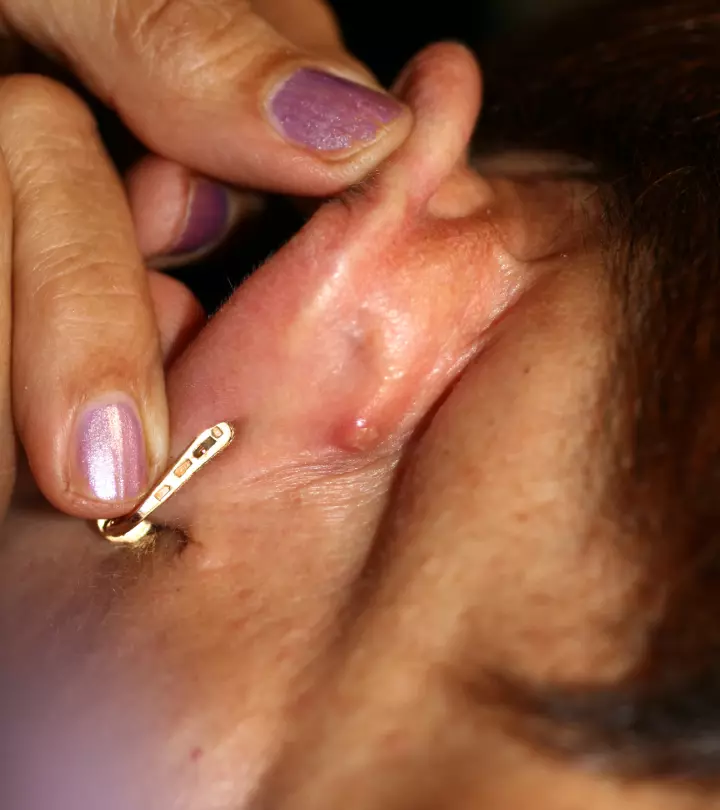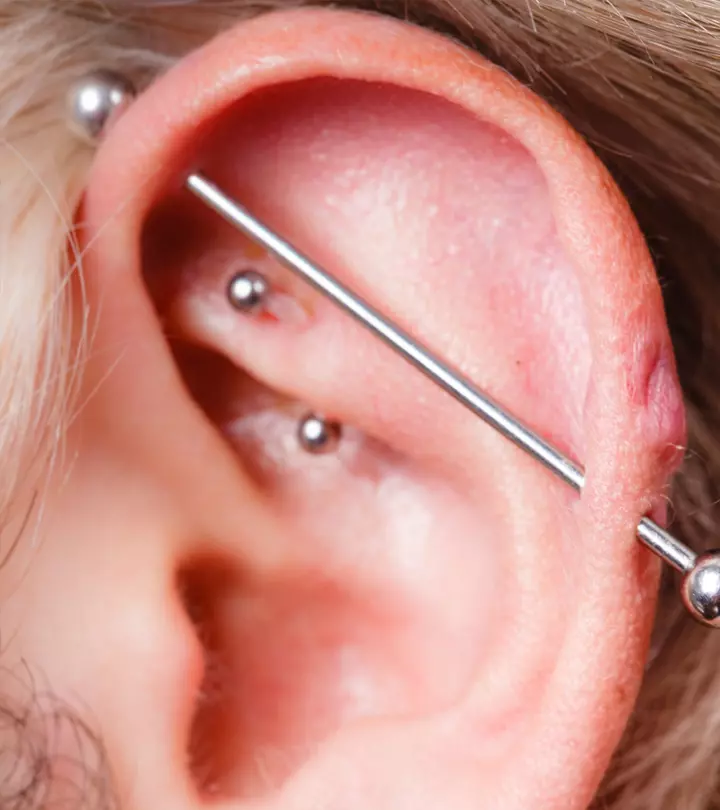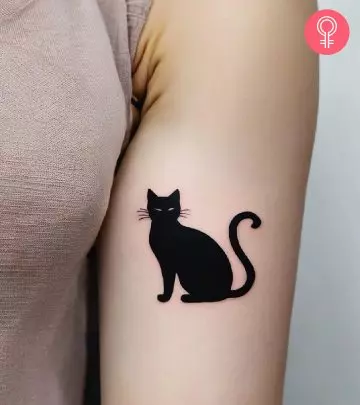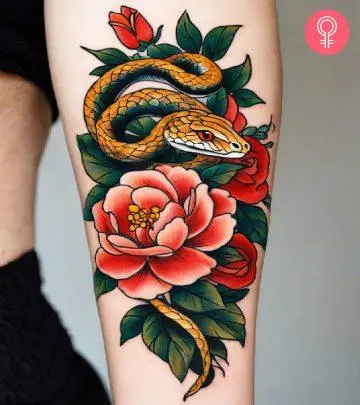Cartilage Piercing Bump: Causes, Treatment, And Prevention
Conquer cartilage piercing bumps with expert healing and prevention hacks.

Image: Shutterstock
Cartilage piercings are a form of body modification involving piercing the structural connective tissue of the nose and stiff upper part of your ears. While these popular facial piercings are great for self-expression, they also result in complications such as cartilage piercing bumps, adding an unwanted touch to your overall look. The bump is often a small and raised area of the skin, on or near the cartilage piercing that people usually find unpleasant to look at. They may or may not be painful but can take a long time to heal. In this detailed article, we will help you understand the secret behind these bumps, including their causes, risk factors, treatment options, and offer preventive measures. Read on to find out!
 Piercing Guide: Cartilage Piercings
Piercing Guide: Cartilage Piercings- Placement: Various locations on the ear and the nose
- Best Jewelry: Studs, hoops, and captive bead rings
- Cost: $35 to $50
- Pain Level: Medium
- Healing Time: 6 to 12 months
In This Article
What Is A Cartilage Piercing Bump?
A cartilage piercing bump is a raised red or flesh-colored pimple-like formation that may develop around a cartilage piercing. Also known as the “mystery bump,” it may occur due to various factors like an infection or trauma during the healing process. Depending on its type, the bump may be small or swollen, tender, itchy, or may contain pus or fluid. Piercing bumps are just raised skin, but some people may notice scars once they heal. Below are some common types of scars that may develop around your piercing holes:
Keloids: These are raised scars that form at the site of a wound or injury, such as a piercing. They can be itchy, tender, or even painful and extend beyond the original wound (1). However, it is important to note that keloids rarely form around piercings of any kind. Such raised skin is quite simply an ear or nose piercing bump.
Hypertrophic Scars: These are similar to keloids; however, unlike them, they are restricted to the area within the original wound (2). Hypertrophic scars are usually raised and red, and they may be itchy or painful.
Granulomas: They are small, reddish bumps that usually form around piercings due to inflammation (3). They may contain pus or fluid and can be tender to the touch.
Cutaneous Abscesses: Also known as an infection pustule or pimple, it is a collection of pus caused by a bacterial infection. It appears as a painful, swollen lump near the piercing site that may resolve without medical intervention (4).
 Did You Know?
Did You Know?It is important to note that not all bumps around a piercing are necessarily infected. They occur due to irritation or the body’s natural response to an injury and may resolve on their own. In such cases, how does one confirm whether they have an infected bump around their cartilage piercing? The signs given in the next section may help.
Key Takeaways
- Cartilage piercing bumps may include keloid scars, granulomas, cutaneous abscesses, and hypertrophic scars.
- Signs of infection of these bumps include redness, swelling, pain, warmth, smelly discharge, and fever.
- They are commonly caused due to infections, lack of proper aftercare, allergic reactions to metals, and use of piercing guns.
- Preventive measures to tackle these bumps include choosing reputable piercing studios, following proper aftercare practices, and using high-quality jewelry.
Signs Of An Infected Cartilage Piercing Bump

An infected cartilage piercing bump may have one or more of the following signs and symptoms:
- It may appear red and swollen.
- You may experience pain or tenderness on and around it.
- The area may feel warm to the touch.
- It may ooze pus or yellow, green, or bloody discharge with a foul odor.
- In case of a severe infection, you may develop a fever or experience chills (6).
Having a pus-filled bump on your cartilage piercing with any of these symptoms is frustrating and a cause for concern. However, consulting with a decent piercer or healthcare provider can help you deal with it. Read on to understand why these infected bumps occur.
Causes Of Cartilage Piercing Bumps
A cartilage piercing is technically an open wound in the skin and may take many months to completely heal. During this period, it is not unusual to develop a flesh-colored or red bump on the piercing site. However, sometimes these bumps may occur due to reasons that are not a part of the piercing’s natural healing process. These include the following:
- Skin Trauma Or Inflammation
Anecdotal evidence suggests that the primary cause of cartilage piercing bumps is trauma or irritation to the piercing site. Further, keloid, a common type of bump that may occur on cartilage piercings, is also usually a response to skin trauma or inflammation (1). These may occur if your piercing jewelry gets stuck in your clothes or gets infected due to frequent touching. Therefore, it is important to handle your new piercing with extreme care.
- Infections
Inflammation resulting in cartilage piercing bumps may also occur if your piercing gets infected (7). Research has shown that cartilage piercings are more prone to keloid formation due to prolonged wound healing after infections (8). Infections may occur due to several reasons, such as touching the piercing with dirty hands, which may introduce bacteria to it, or improper aftercare practices.
- Allergic Reactions

You may also experience inflammation if you develop an allergic reaction to the metal of your piercing jewelry, such as nickel. While the metal is not directly used to manufacture piercing jewelry, it is sometimes used as an additive in precious metals like gold (9). If you have sensitive skin or are allergic to nickel, it is a good idea to ensure that your jewelry is hypoallergenic and free of such metals (10).
- Improper Aftercare Practices
Failing to clean the piercing regularly or using harsh cleaning solutions may also disrupt its healing process, leading to dryness and itching, which may result in a bump. Therefore, it is recommended to diligently follow the aftercare guidelines given by your piercer. These may include simple practices like washing your piercing with saline solution and avoiding harsh, fragrance-free soaps (11).
- Use Of Piercing Guns

Anecdotal evidence suggests that using a piercing gun may cause more trauma to the piercing site, leading to bump formation. However, research suggests that all piercing methods may lead to the same extent of cartilage damage (12). That said, it is still recommended to avoid piercing guns, as their body is made of plastic. This makes them hard to sterilize in an autoclave, a machine that uses high temperatures to kill harmful germs on piercing equipment, leaving you open to the risk of infection.
 Did You Know?
Did You Know?Cartilage piercing bumps can develop in anyone who has a cartilage piercing, but some people are more prone to them than others. Check out the following section talking about the risk factors that increase your chances of getting them.
Risk Factors Of Cartilage Piercing Bumps
Here are some risk factors that may increase the likelihood of the development of bumps on cartilage piercings:
- Genetic Factors
Genetic predisposition plays a significant role in the formation of a bump next to cartilage piercings. Research suggests that individuals with darker skin tones of Asian, African, or Hispanic origin are more likely to develop these bumps as compared to those of European descent with lighter skin. The incidence of people with darker skin tone developing these bumps ranges from 4.5-16% (1). Further, you may also be at a risk of developing piercing bumps if you have a positive family history of them.
- Weak Immune System
Research suggests that people with certain health conditions like diabetes may have a weaker immune system. This makes it difficult for their body to fight off invading pathogens, thereby making them more susceptible to infections (13). Therefore, if you are someone with a weak immune system, chances are that you may be at an increased risk of developing infections and bumps.
Getting these irritating bumps can be a bummer. But the good news is it is possible to treat it with some simple steps! Scroll down to learn how to get rid of a cartilage piercing bump.
How To Treat A Cartilage Piercing Bump
Treating a cartilage piercing bump requires gentle care to avoid further infection or complication. Below is a step-by-step cartilage piercing bump treatment guide you may follow:
- Wash Your Hands

Ensure to wash your hands thoroughly with an antibacterial soap and warm water before touching your piercing. This will prevent the introduction of germs and bacteria to the bump and prevent the risk of infections.
- Eliminate Irritating Factors
Sometimes, cartilage piercing bumps may occur due to irritants in skincare products, due to a too tight or loose piece of jewelry, or even from snagging or sleeping on new piercings (10). Before treating the bump, ensure you stay away from all these aggravating factors.
- Clean The Area Well
Use a sterile saline wound wash or a fragrance-free, mild soap to clean the area around the piercing. Rinse with clean water and pat dry using a clean paper towel. It is recommended to do this at least twice a day (11).
- Apply Warm Compress
Soak a clean cloth or cotton ball in a warm saline solution and gently apply it to the bump for 5-10 minutes. While this may not completely treat the bump, it may help reduce swelling and soothe the area (14).
- Apply A Healing Ointment

If your healthcare professional has prescribed an antibiotic ointment, you can apply it at this step. Use a Q-tip to apply it evenly on the bump and the surrounding affected skin. If you are experiencing any inflammation or pain, you may also ask your doctor for OTC painkillers. Further, if your piercing bump is a keloid, you may have to opt for treatment options like surgical excision, laser treatment, and steroid injections (1).
Iskanderia, a grad student and blogger, shared that she used aspirin paste to treat the bumps on her infected tragus piercing (done on the small, thick flap of cartilage over the ear canal). She states in one of her blog posts, “After that second day, I scrape off a thick gunk of aspirin, lymph, and blood and find both sides of my right tragus completely flat, and strangely, not at all irritated (i).”
- Use Hypoallergenic Jewelry
Hypoallergenic jewelry, made from materials like titanium or surgical steel, can minimize irritation and allergic reactions. This can further help in healing cartilage piercing bumps by curbing inflammation and promoting faster recovery.
If the bump persists or becomes increasingly painful, swollen, or filled with pus, it is essential to seek advice from a professional piercer or healthcare provider immediately. Another important thing is taking preventive measures to avoid such a painful bump on the cartilage piercing altogether. Scroll down to find out how.
How To Prevent A Bump On A Cartilage Piercing
If you have been wondering how to get rid of piercing bumps and prevent them, here are some precautionary measures you can follow to ensure your cartilage piercing stays bump-free:
- Opt for a piercing studio that offers a sterile environment, and ensure that you get the procedure done by a piercing expert who is skilled at performing the type of piercing you want to get.
- Keep your fresh piercing clean by washing it regularly with a sterile saline solution or a saline-based wound wash. It is recommended to do this until your piercing heals.
- Use a clean cotton pad or swab to gently clean around the piercing so that no crust or debris can accumulate.
- Avoid using hydrogen peroxide or alcohol-based harsh cleansers as they may dry out the skin and delay healing (11).
- Avoid touching your piercing with unwashed hands, as it may introduce bacteria to the area and increase the risk of infection.
- Avoid sleeping on the new piercing side, as pressure and friction from the pillow may irritate it and contribute to the formation of bumps.
- Avoid using cheap or low-quality jewelry as they may cause irritation or allergic reactions. Instead, opt for high-quality jewelry made from materials such as surgical-grade stainless steel, titanium, sterling silver, or gold (10).
- Avoid twisting or turning the jewelry unnecessarily, as this can cause irritation and delay the healing process.
- Wait until the piercing is fully healed before changing the jewelry, as changing it too soon may disrupt the healing process.
- Keep your haircare, skincare, and makeup products away from the piercing to prevent irritation and contamination.
- Be mindful of activities that could potentially injure or snag the piercing, such as wearing headphones or playing sports.
Usually, cartilage piercings take longer to heal as compared to other piercings. It is recommended to be patient and follow proper aftercare procedures consistently until the piercing is fully healed. Meanwhile, if you notice any signs of infection or unusual swelling, consult your piercer or medical professional for appropriate treatment.
The term cartilage piercing bump is often used interchangeably with keloids, but are they really the same? Let us find out in the following section.
Cartilage Piercing Bumps Vs. Keloids
Although they are often used interchangeably, cartilage piercing bumps and keloids are not the same.
- A cartilage piercing bump is typically a localized reaction to trauma or irritation, often appearing as a small raised area around the piercing site. This may either be a keloid, hypertrophic scar, granuloma, or simply an infection pustule.
- Conversely, a keloid is an overgrowth of scar tissue beyond the boundaries of the original wound. While a piercing bump may be a keloid, not all of them are keloids.
If you are worried about how to tell apart a keloid from other piercing bump types, the one sign you should keep in mind is that keloids extend beyond the original piercing site. Additionally, they also tend to grow in size without proper treatment (1).
Complications arising from cartilage piercing bump infections are rare. But if they do not get better even after a week of home treatment, delaying medical attention may lead to the infection worsening. Let us find out when you should contact a doctor about your condition.
When To See A Doctor Or Piercer For A Cartilage Piercing Bump

If your cartilage piercing bump does not improve within a week of treatment and shows worsening signs of infection, such as increased redness, warmth, swelling, discharge, and pain, consider seeking advice from your doctor or piercer. Apart from this, if you experience high fever and chills, chances are that it may be a sign of a severe infection (15). It is hence recommended you seek medical advice immediately.
Infographic: Causes And Treatment Of A Cartilage Piercing Bump
Cartilage piercings are among the most popular and stylish options for piercings. Yet they sometimes do bring an unpleasant surprise, namely bumps. These bumps appear on the cartilage piercings and can hinder your healing if not treated properly. Explore what causes these bumps and how to treat them effectively to ensure that your cartilage piercing heals beautifully. Scroll down to see the infographic!
Illustration: StyleCraze Design Team
Getting a cartilage piercing bump can be a frustrating and uncomfortable experience. These usually happen due to various reasons, trauma, metal allergies, improper piercing techniques, or poor aftercare. While some bumps usually heal within a week, keloids may take longer to heal. However, watch out for signs of infection. Consult a doctor or your piercer if you notice redness, swelling, pain, smelly discharge from the bump, and fever. It’s crucial to adopt proper piercing aftercare practices and get the piercing from reputable piercing studios to reduce the risk of developing these bumps and marring your personal style statement. However, if you still get them, following simple steps like washing them with a saline solution twice a day and using warm compresses may come in handy.
Frequently Asked Questions
How long does it take for a cartilage piercing bump to go away?
The time it takes for a cartilage piercing bump to go away may vary greatly depending on individual healing processes, care, and the severity of the bump. Anecdotal evidence suggests that in most cases, it may start to diminish after a few days and resolve within a few weeks to a couple of months.
Can I use home remedies to treat cartilage piercing bumps?
Yes, you may use home remedies to treat cartilage piercing bumps. Anecdotal evidence suggests that chamomile tea compresses and tea tree oil may help reduce the appearance of these bumps. However, it is essential to proceed with these home remedies with caution, as they may be harsh on the skin and further irritate your piercing.
Should I be concerned if my cartilage piercing bump is bleeding?
Yes, you should be concerned if your cartilage piercing bump is bleeding, as this may indicate additional trauma to the already infected piercing. In such a case, it is recommended to clean the area gently with a saline solution and consult a reputable piercer or a doctor for further evaluation.
A cartilage piercing bump can bring along discomfort, and swelling, and just mar your aesthetic. If you are dealing with such bumps, then check out this informative video on how to treat it. Click play now!
Personal Experience: Source
StyleCraze's articles are interwoven with authentic personal narratives that provide depth and resonance to our content. Below are the sources of the personal accounts referenced in this article.
(i) For the DIY surgery files: aspirin paste kills lumps on your cartilage piercings.
https://iskanderia.livejournal.com/10782.html
References
Articles on StyleCraze are backed by verified information from peer-reviewed and academic research papers, reputed organizations, research institutions, and medical associations to ensure accuracy and relevance. Read our editorial policy to learn more.
- Keloid
https://www.ncbi.nlm.nih.gov/books/NBK507899/ - Hypertrophic scarring
https://www.ncbi.nlm.nih.gov/books/NBK470176/ - Granuloma
https://www.ncbi.nlm.nih.gov/books/NBK554586/ - Targeting bacterial abscess formation
https://www.ncbi.nlm.nih.gov/pmc/articles/PMC5078668/ - Efficacy of triple therapy in auricular keloids
https://www.ncbi.nlm.nih.gov/pmc/articles/PMC4134660/ - Body piercing infections
https://www.ncbi.nlm.nih.gov/books/NBK537336/ - About inflammation and infection
https://www.ncbi.nlm.nih.gov/pmc/articles/PMC3564704/ - Factors associated with postpiercing auricular cartilage keloids
https://pubmed.ncbi.nlm.nih.gov/22015121/ - Contact sensitivity to nickel and other metals in jewelry reactors
https://pubmed.ncbi.nlm.nih.gov/10863220/ - Jewelry for initial piercings
https://safepiercing.org/jewelry-for-initial-piercings/ - Suggested aftercare for body piercings
https://safepiercing.org/aftercare/ - Ear piercing techniques and their effect on cartilage a histologic study
https://pubmed.ncbi.nlm.nih.gov/17684004/ - Type 2 diabetes and its impact on the immune system
https://www.ncbi.nlm.nih.gov/pmc/articles/PMC7475801/ - The effect of warm moist compresses in peripheral intravenous catheter-related phlebitis
https://www.sciencedirect.com/science/article/abs/pii/S1462388923001722 - Physiology fever
https://www.ncbi.nlm.nih.gov/books/NBK562334/
Read full bio of J’son D’souza
Read full bio of Gracia Odile
Read full bio of Madhumati Chowdhury
Read full bio of Vaishali Sinha


























Community Experiences
Join the conversation and become a part of our empowering community! Share your stories, experiences, and insights to connect with other beauty, lifestyle, and health enthusiasts.